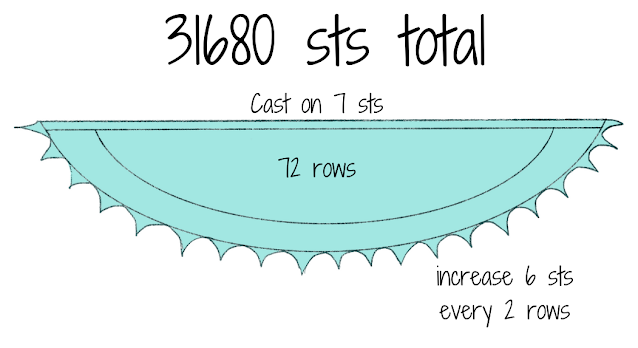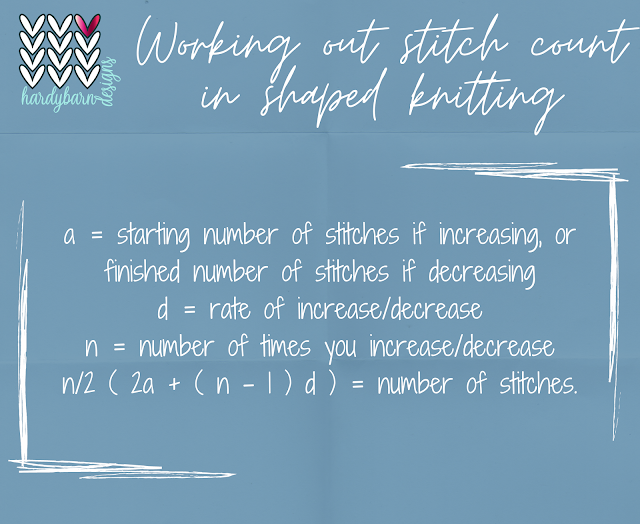Tutorial: Working out stitch count in shaped knitting [includes calculator]
Okay, so this is quite a mathy tutorial. I wanted to share this, in a knitting context, because I've found it to be quite useful. There is a calculator at the bottom, so (hopefully) it can do the working out for you.
This is something that I’ve researched as I was very unsure that I would have enough yarn to finish a shawl I was working on.
I was able to work out relatively easily how many stitches I needed to complete the shawl and whether I had a enough yarn to work another repeat. I’ve used it quite a few times since then, when yarn quantity was a bit tight; plus, it's very helpful in designing too.
Measuring Yarn in Grams/M/Yds
Knowing how many stitches is only useful, if you know how much yarn you need to work X number of stitches. There are quite a few ways of working this out. I’ve mentioned one of them before when I working out yarn amounts for intarsia. It’s the same principle here.
In that tutorial, I explained how to measure out a metre or yard of yarn and see how many stitches you can work. In that example, I worked 64 stitches in a metre. If working in imperial, divide this number by 36 and that’s how many stitches can be worked in an inch. If working in metric, divide this number by 100 and that’s how many stitches can be worked in a centimetre. My number is 0.64 (rounded to 2 decimal places). I can work 0.64 stitches in 1 centimetre.
If you’ve made a swatch, then life is a lot easier. Take the amount of stitches cast on in the swatch and multiply by the number of rows – weigh your dry swatch and divide the number of stitches by the weight. This works in either imperial or metric. So for example, I have 2600 sts in my swatch and it weighs 10.82g. 2600 / 10.82 = 240 sts per gram.
In a pinch, you can use the second method to work out when you are halfway through your knitting too. If your knitting is square at the point where you need to measure, place your knitting on waste yarn and weigh it. Work out how many stitches you’ve worked by multiplying cast on stitches by rows and repeat the calculation I’ve just mentioned. I’ve used all 3 methods, just pick whichever is going to be easiest.
Examples
OK, so you have a number that tells you either how much yarn is in a gram or in a centimetre/inch.
I’ll start with a basic shape. For example, a shawl. The rates of increase/decrease tend to remain the same throughout. If you’re making a top down shawl, you could cast on 7 sts and increase 2 sts every row. This is going to be a tiny little shawl that only has 20 rows.
The numbers you need for the formula are:
a = the starting number of stitches
d = rate of increase
n = how many times you repeat the rate of increase
a = 7 ( cast on number)
d = 2 (stitches increased every row)
n = 20 (number of rows with an increase)
n/2 ( 2a + (n-1)d) = number of sts.
20/2 ( (2 x 7) + (20-1) x 2)
Condensed 10 (14 + (19 x 2) ) = 520 sts in our mini shawl
To prove it works, here is the long version.
7 + 9 + 11 + 13 + 15 + 17 + 19 + 21 + 23 + 25 + 27 + 29 + 31 + 33 + 35 + 37 + 39 + 41 + 43 + 45 = 520 sts
It saves a lot of time but what do you do if you’re not increasing on every row. How about a shawl that increases 6 sts every 2 rows. Let’s cast on 7 sts like before, but increase 6 sts every 2 rows and let’s make a big shawl that has 144 rows.
d = 6 (rate of increase every other row)
n = 72 (number of rows / 2, as you are increasing over 2 rows, so you only increase 72 times)
72/2 ( ( 2 x 7 ) + ( 72 – 1 ) x 6)
36 ( 14 + (71 x 6) ) = 15840 sts
However, we need to multiply this by 2 because the increases are worked over 2 rows. 15840 x 2 = 31680 stitches in the shawl.
Remember to take into account, cast on and cast off rows if yarn is really tight. I always add about 4 rows of stitches for the cast off.
Sometimes, it is quicker to portion your shape up like the intarsia method and work out how many stitches you have, but if the rate of decrease isn’t constant then repeat the formula for each different rate of increase. A sleeve is a perfect example of this. For example, the instructions say cast on 46 sts, work 8 rows in rib, increase at each end of the 7th row and every following 6 th row 4 times, then every 8th row 9 times.
The first 14 rows are worked straight, so that’s easy. 46 x 14 = 644 sts in the first 14 rows.
Next, use the formula to work out the first set of increases.
a = 46 (starting stitches)
d = 2 (rate of increase worked every 6 rows)
n = 5 (repeated 5 times)
2.5 ( 92 + (4 x 2)) = 250 sts x 6 (as increase is worked over 6 rows ) = 1500 sts in first set of increases
Repeat the formula for the final set of increases.
a = 56 ( cast on stitches + 10 sts increased previously)
d = 2 (rate of increase worked every 8 rows)
n = 9 (repeated 9 times)
4.5 ( 112 + ( 8 x 2)) = 576 sts x 8 (as increase is worked over 8 rows = 4608 sts in second set of increases.
Add your all your stitches together – 644 + 1500 + 4608 = 6752 sts in sleeve.
The formula works a little differently if you are using decreases. You just have to use the finished number of stitches instead of what you start with.
a = finished number of stitches
d = rate of decrease
n = number of times you decrease
Finally, to work out if you have enough yarn then it depends on how you’ve defined your yarn quantity.
If you know how much yarn you have per gram then divide the number of stitches by this number e.g. 4608 sts / 240 per gram = 19.2 grams needed.
If you’ve worked it out by length then divide the number of stitches by the number per cm / inch e.g. 31680 sts / 0.64 sts per cm = 49500cm or 495m of yarn.
I’ve given lots of examples to explain different situations but here’s the basic formula again.
a = starting number of stitches if increasing,
or finished number of stitches if decreasing
d = rate of increase/decrease
n = number of times you increase/decrease
n/2 ( 2a + ( n – 1 ) d ) = number of stitches.
d = rate of increase/decrease
n = number of times you increase/decrease
n/2 ( 2a + ( n – 1 ) d ) = number of stitches.
Just be aware that the accuracy of this can change, if different stitch techniques have been used e.g. lace will take less yarn, cables more; plus, it all depends on how accurately you worked out the yarn per metre, yard or gram.
Hopefully, this will work properly but I've set up a calculator, so you can just enter your numbers in and it does the work for you.




interesting work..
ReplyDelete